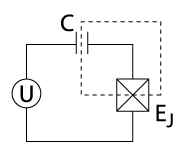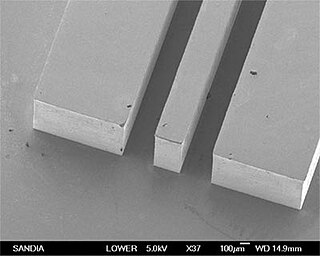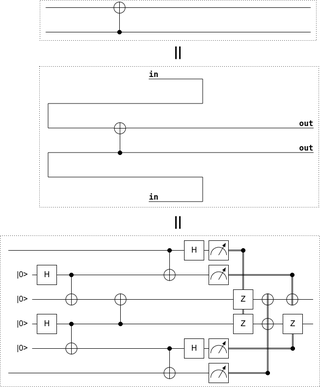Related Research Articles

A surface acoustic wave (SAW) is an acoustic wave traveling along the surface of a material exhibiting elasticity, with an amplitude that typically decays exponentially with depth into the material, such that they are confined to a depth of about one wavelength.
Quantum error correction (QEC) is used in quantum computing to protect quantum information from errors due to decoherence and other quantum noise. Quantum error correction is theorised as essential to achieve fault tolerant quantum computing that can reduce the effects of noise on stored quantum information, faulty quantum gates, faulty quantum preparation, and faulty measurements. This would allow algorithms of greater circuit depth.

In quantum computing, a charge qubit is a qubit whose basis states are charge states. In superconducting quantum computing, a charge qubit is formed by a tiny superconducting island coupled by a Josephson junction to a superconducting reservoir. The state of the qubit is determined by the number of Cooper pairs that have tunneled across the junction. In contrast with the charge state of an atomic or molecular ion, the charge states of such an "island" involve a macroscopic number of conduction electrons of the island. The quantum superposition of charge states can be achieved by tuning the gate voltage U that controls the chemical potential of the island. The charge qubit is typically read-out by electrostatically coupling the island to an extremely sensitive electrometer such as the radio-frequency single-electron transistor.
Superconducting quantum computing is a branch of solid state quantum computing that implements superconducting electronic circuits using superconducting qubits as artificial atoms, or quantum dots. For superconducting qubits, the two logic states are the ground state and the excited state, denoted respectively. Research in superconducting quantum computing is conducted by companies such as Google, IBM, IMEC, BBN Technologies, Rigetti, and Intel. Many recently developed QPUs use superconducting architecture.

In quantum computing, more specifically in superconducting quantum computing, flux qubits are micrometer sized loops of superconducting metal that is interrupted by a number of Josephson junctions. These devices function as quantum bits. The flux qubit was first proposed by Terry P. Orlando et al. at MIT in 1999 and fabricated shortly thereafter. During fabrication, the Josephson junction parameters are engineered so that a persistent current will flow continuously when an external magnetic flux is applied. Only an integer number of flux quanta are allowed to penetrate the superconducting ring, resulting in clockwise or counter-clockwise mesoscopic supercurrents in the loop to compensate a non-integer external flux bias. When the applied flux through the loop area is close to a half integer number of flux quanta, the two lowest energy eigenstates of the loop will be a quantum superposition of the clockwise and counter-clockwise currents. The two lowest energy eigenstates differ only by the relative quantum phase between the composing current-direction states. Higher energy eigenstates correspond to much larger (macroscopic) persistent currents, that induce an additional flux quantum to the qubit loop, thus are well separated energetically from the lowest two eigenstates. This separation, known as the "qubit non linearity" criteria, allows operations with the two lowest eigenstates only, effectively creating a two level system. Usually, the two lowest eigenstates will serve as the computational basis for the logical qubit.
A quantum bus is a device which can be used to store or transfer information between independent qubits in a quantum computer, or combine two qubits into a superposition. It is the quantum analog of a classical bus.
A macroscopic quantum state is a state of matter in which macroscopic properties, such as mechanical motion, thermal conductivity, electrical conductivity and viscosity, can be described only by quantum mechanics rather than merely classical mechanics. This occurs primarily at low temperatures where little thermal motion is present to mask the quantum nature of a substance.

A quantum machine is a human-made device whose collective motion follows the laws of quantum mechanics. The idea that macroscopic objects may follow the laws of quantum mechanics dates back to the advent of quantum mechanics in the early 20th century. However, as highlighted by the Schrödinger's cat thought experiment, quantum effects are not readily observable in large-scale objects. Consequently, quantum states of motion have only been observed in special circumstances at extremely low temperatures. The fragility of quantum effects in macroscopic objects may arise from rapid quantum decoherence. Researchers created the first quantum machine in 2009, and the achievement was named the "Breakthrough of the Year" by Science in 2010.
Circuit quantum electrodynamics provides a means of studying the fundamental interaction between light and matter. As in the field of cavity quantum electrodynamics, a single photon within a single mode cavity coherently couples to a quantum object (atom). In contrast to cavity QED, the photon is stored in a one-dimensional on-chip resonator and the quantum object is no natural atom but an artificial one. These artificial atoms usually are mesoscopic devices which exhibit an atom-like energy spectrum. The field of circuit QED is a prominent example for quantum information processing and a promising candidate for future quantum computation.

In quantum computing, and more specifically in superconducting quantum computing, a transmon is a type of superconducting charge qubit designed to have reduced sensitivity to charge noise. The transmon was developed by Robert J. Schoelkopf, Michel Devoret, Steven M. Girvin, and their colleagues at Yale University in 2007. Its name is an abbreviation of the term transmission line shunted plasma oscillation qubit; one which consists of a Cooper-pair box "where the two superconductors are also [capacitively] shunted in order to decrease the sensitivity to charge noise, while maintaining a sufficient anharmonicity for selective qubit control".
In quantum mechanics, the cat state, named after Schrödinger's cat, is a quantum state composed of two diametrically opposed conditions at the same time, such as the possibilities that a cat is alive and dead at the same time.

Coplanar waveguide is a type of electrical planar transmission line which can be fabricated using printed circuit board technology, and is used to convey microwave-frequency signals. On a smaller scale, coplanar waveguide transmission lines are also built into monolithic microwave integrated circuits.

Robert J. Schoelkopf III is an American physicist, most noted for his work on quantum computing as one of the inventors of superconducting qubits. Schoelkopf's main research areas are quantum transport, single-electron devices, and charge dynamics in nanostructures. His research utilizes quantum-effect and single-electron devices, both for fundamental physical studies and for applications. Techniques often include high-speed, high-sensitivity measurements performed on nanostructures at low temperatures. Schoelkopf serves as director of the Yale Center for Microelectronic Materials and Structures and as associate director of the Yale Institute for Nanoscience and Quantum Engineering. Since 2014, Schoelkopf is also the Director of the Yale Quantum Institute.

Michel Devoret is a French physicist and F. W. Beinecke Professor of Applied Physics at Yale University. He also holds a position as the Director of the Applied Physics Nanofabrication Lab at Yale. He is known for his pioneering work on macroscopic quantum tunneling, and the single-electron pump as well as in groundbreaking contributions to initiating the fields of circuit quantum electrodynamics and quantronics.

Irfan Siddiqi is an American physicist and currently a professor of physics at the University of California, Berkeley and a faculty scientist at Lawrence Berkeley National Laboratory (LBNL). He currently is the director of the Quantum Nanoelectronics Laboratory at UC Berkeley and the Advanced Quantum Testbed at LBNL. Siddiqi is known for groundbreaking contributions to the field of superconducting quantum circuits, including dispersive single-shot readout of superconducting quantum bits, quantum feedback, observation of single quantum trajectories, and near-quantum limited microwave frequency amplification. In addition to other honors, for his pioneering work in superconducting devices, he was awarded with the American Physical Society George E. Valley, Jr. Prize in 2006, "for the development of the Josephson bifurcation amplifier for ultra-sensitive measurements at the quantum limit." Siddiqi is a fellow of the American Physical Society and a recipient of the UC Berkeley Distinguished Teaching Award in 2016.

Jerry M. Chow is a physicist who conducts research in quantum information processing. He has worked as the manager of the Experimental Quantum Computing group at the IBM Thomas J. Watson Research Center in Yorktown Heights, New York since 2014 and is the primary investigator of the IBM team for the IARPA Multi-Qubit Coherent Operations and Logical Qubits programs. After graduating magna cum laude with a B.A. in physics and M.S. in applied mathematics from Harvard University, he went on to earn his Ph.D. in 2010 under Robert J. Schoelkopf at Yale University. While at Yale, he participated in experiments in which superconducting qubits were coupled via a cavity bus for the first time and two-qubit algorithms were executed on a superconducting quantum processor.
In quantum computing, a qubit is a unit of information analogous to a bit in classical computing, but it is affected by quantum mechanical properties such as superposition and entanglement which allow qubits to be in some ways more powerful than classical bits for some tasks. Qubits are used in quantum circuits and quantum algorithms composed of quantum logic gates to solve computational problems, where they are used for input/output and intermediate computations.

Sycamore is a transmon superconducting quantum processor created by Google's Artificial Intelligence division. It has 53 qubits.

Quantum gate teleportation is a quantum circuit construction where a gate is applied to target qubits by first applying the gate to an entangled state and then teleporting the target qubits through that entangled state.
Andrew A. Houck is an American physicist, quantum information scientist, and professor of electrical and computer engineering at Princeton University. He is director of the Co-Design Center for Quantum Advantage, a national research center funded by the U.S. Department of Energy Office of Science, as well as co-director of the Princeton Quantum Initiative. His research focuses on superconducting electronic circuits to process and store information for quantum computing and to simulate and study many-body physics. He is a pioneer of superconducting qubits.
References
- ↑ "Physicists count sound particles with quantum microphone". ScienceDaily. Retrieved 2021-11-18.
- ↑ Chu, Yiwen; Kharel, Prashanta; Renninger, William H.; Burkhart, Luke D.; Frunzio, Luigi; Rakich, Peter T.; Schoelkopf, Robert J. (13 October 2017). "Quantum acoustics with superconducting qubits". Science. 358 (6360): 199–202. arXiv: 1703.00342 . Bibcode:2017Sci...358..199C. doi:10.1126/science.aao1511. PMID 28935771. S2CID 206662360.
- ↑ Satzinger, K. J.; Zhong, Y. P.; Chang, H.-S.; Peairs, G. A.; Bienfait, A.; Chou, Ming-Han; Cleland, A. Y.; Conner, C. R.; Dumur, É; Grebel, J.; Gutierrez, I.; November, B. H.; Povey, R. G.; Whiteley, S. J.; Awschalom, D. D.; Schuster, D. I.; Cleland, A. N. (November 2018). "Quantum control of surface acoustic-wave phonons". Nature. 563 (7733): 661–665. arXiv: 1804.07308 . Bibcode:2018Natur.563..661S. doi:10.1038/s41586-018-0719-5. PMID 30464339. S2CID 53711669.
- ↑ Chu, Yiwen; Kharel, Prashanta; Yoon, Taekwan; Frunzio, Luigi; Rakich, Peter T.; Schoelkopf, Robert J. (21 November 2018). "Creation and control of multi-phonon Fock states in a bulk acoustic-wave resonator". Nature. 563 (7733): 666–670. arXiv: 1804.07426 . Bibcode:2018Natur.563..666C. doi:10.1038/s41586-018-0717-7. PMID 30464340. S2CID 53581929.
- ↑ Andersson, Gustav; Suri, Baladitya; Guo, Lingzhen; Aref, Thomas; Delsing, Per (November 2019). "Non-exponential decay of a giant artificial atom". Nature Physics. 15 (11): 1123–1127. arXiv: 1812.01302 . Bibcode:2019NatPh..15.1123A. doi:10.1038/s41567-019-0605-6. S2CID 119468686.
- ↑ Aydin, Alhun; Keski-Rahkonen, Joonas; Heller, Eric J. (2023-12-11). "Quantum Acoustics Spawns Planckian Resistivity". arXiv: 2303.06077 [cond-mat.str-el].